If you’re looking for tips about how to grow your newsletter list, here is a 4 step guide collect email addresses for you ecommerce store or business.
According to a 2018 report by Monetate, a first-time customer, on average, will take about three and a half shopping sessions- over about 25 days- to finally make up their mind and close a sale.
Let that sink in for a minute.
In other words, you probably have better chances of seeing a full cycle of all four moon phases before you finally convert a new visitor into a paying customer. And that’s only if you’re lucky enough to repeatedly host them in your site.
But, there’s hope.
You can attract them over and over again, and possibly even retain them forever, through a strategic retargeting campaign.
Now, of course, it’s common knowledge by now that there are several aggressive ways to do this. But email marketing remains, by far, the most effective option. Its average click-through rate ranges between 4 and 14%. Compare that to, say, retargeting ads, which only manage a meager 0.51%.
Then let’s jump right into it! Those are, undoubtedly, some good prospects, right?
Well, hold your horses for now.
While the concept of engaging leads via email sounds comparatively simple, there’s one critical step before everything else- collecting emails.
If you’re in a rush you could, of course, make the whole process much simpler by purchasing an email list. But it you’d probably need the success odds of a leprechaun to make it to even 1% CTR.
While sending an email out to thousands or random individuals at a go might seem like a good idea at first, you’ll ultimately come across as a spammer.
That leaves us with only one good option- progressively collecting emails from your warm prospects.
Now that requires patience. And above everything else, it needs a solid strategy. One that’s effectual enough to collect more than you’ll be losing, considering the fact that your overall database will degrade by about 22.5% every 12 months.
And you know what? That’s precisely what we’ll be looking into.
So let’s dive in.
How To Collect Email Addresses: Capitalize on Lightbox Popups Over Traditional Signup Forms
“But where is the newsletter signup form? Oh, there it is. Right at the footer. Let me enter my email address.” Rarely said a new visitor.
If you’ve been lucky enough to progressively attract a substantial number of emails through a signup footer, your call-to-action game must be on an exceptional level. Or your footers basically take up at least half of your web pages.
Even if either of these cases is true, you have a higher likelihood of attracting more emails through convincing popups.
Web visitors simply have no time to crawl and dig around your site. As a matter of fact, only 50%, on average, will scroll further than 1000 pixels. Much fewer eventually proceed all the way to the footer.
Nikki McGonigal, a crafter running a site called Nikki In Stitches, is one entrepreneur who learnt this the hard way. Despite an active blog, she could only draw a 0.4% subscription rate from a traditional signup form positioned on the side.
This is how it looked:
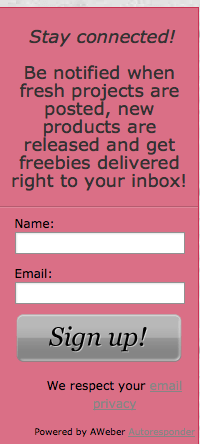
On the bright side, however, at least she had a brilliant idea of combining that with a lightbox popup. While the former struggled to remain relevant, the latter was recording more than ten times as many subscriptions. In eight months, it boasted a solid 5.5% subscription rate.
Quite impressive, to say the least. Here’s the magical tool:
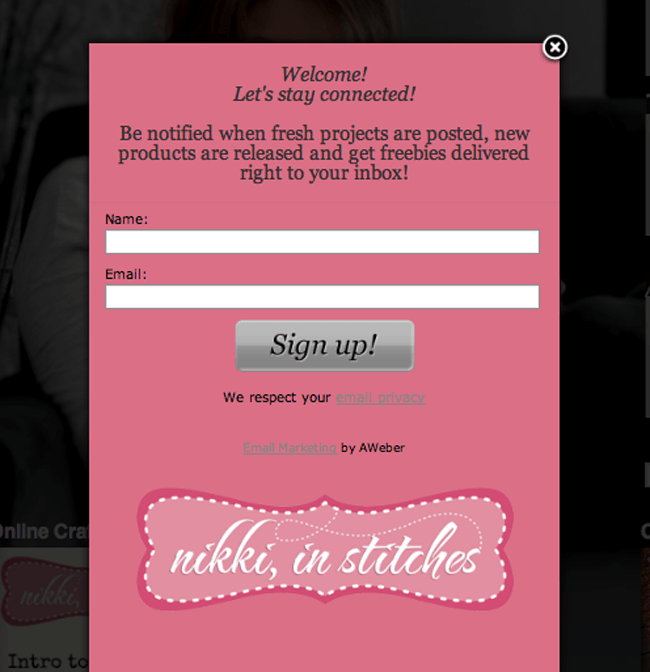
Goes to show that although lightbox popups are considered uncourteous by some web users, they are way more effective than traditional sign up forms.
How To Collect Email Addresses: Offer Signup Incentives
Okay, we have ourselves a colorful lightbox popup. But why are visitors still reluctant?
Well, it’s pretty simple.
To define the problem accordingly, here’s an interesting, yet often overlooked fact about web users.
We just don’t surf the web randomly giving out our email addresses to every Tom, Dick and Harry with a lightbox popup. And that also includes sites that we may already be warming up to.
The last thing anyone needs is a crammed email inbox with barely any breathing space. So you have to find a way convince me to willingly surrender my precious email address.
Well, of course, you could beg. But that would only make you seem suspiciously desperate.
For optimal results, the best way to handle this would offering incentives.
And only clever enticements for that matter. Otherwise, you risk giving out more of your product than you’re actually selling.
You could, for instance, use reverse psychology by capitalizing on your prospects’ possible feelings of guilt. Have a look at this example that popped up as I was surfing through PreApps, a mobile app marketing website.
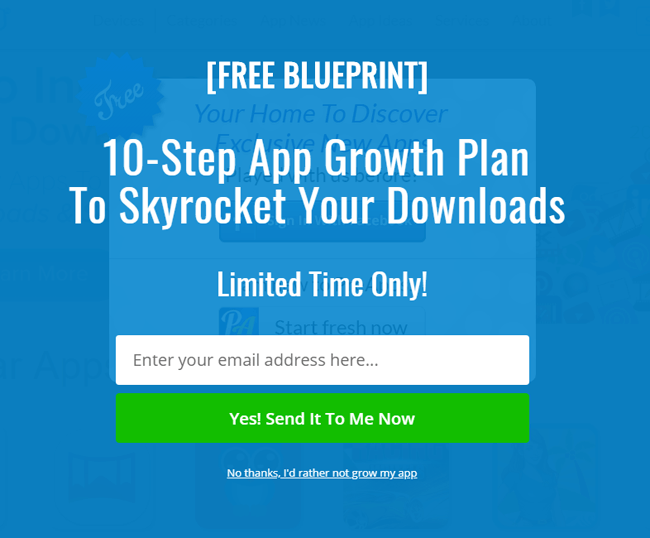
You’re dead right it was easy to ignore everything at first glance. But then something hit me as I hastily scanned for a cancel button.
And guess what?
There was none at all. Instead of the word “cancel”, the popup could only be rejected by clicking on “No thanks, I’d rather not grow my app”.
Then boom!
Hard to believe, but there I was. With guilt written large all over my face.
As you may have probably noticed, the popup further combined that with value. By subscribing, I would also have an informative booklet sent straight to my email.
And that’s another clever approach to email list incentives. It doesn’t take a lot of resources to compile a remarkably informative book that your target audience would appreciate. So, of course, it should only make sense to leverage it to trigger additional subscriptions.
Here’s a basic example I bumped into on Buildfire.
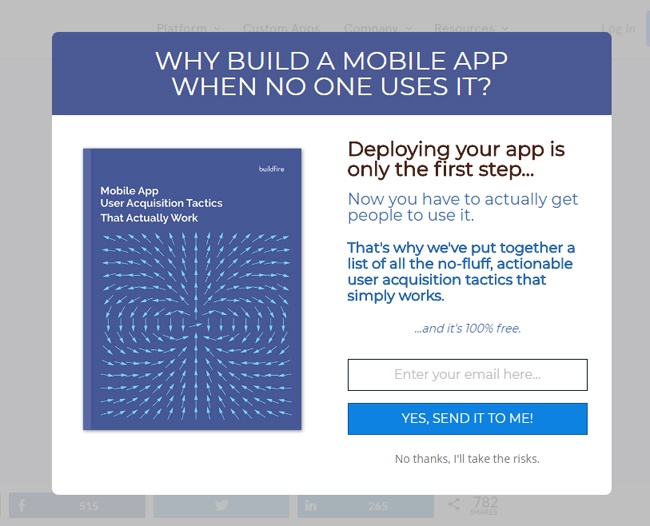
If this still fails to tickle your visitors’ fancy, there are still more than six other creative options that are proving to be increasingly powerful for a wide range of businesses.
Here’s their relative global popularity as of June 2016.
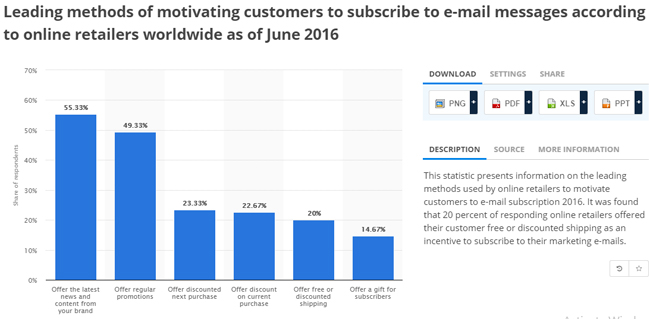
How To Collect Email Addresses: Introduce Popups For Abandoned Carts
Let’s be honest.
Web traffic bouncing is bad for business. And so is webpage abandonment and poor conversion funnels.
However, what we largely consider as the biggest heartbreaker is cart abandonment. You’ve put in a lot of work to qualify and convert a lead only to lose them at the last minute. A moment away from an actual transaction.
Sadly, the lowest average cart abandonment rate a survey has ever recorded is 59.80% by MarketingSherpa in 2006. It has since increased exponentially, and selected study publications like Listrak’s are now reporting rates as high as 78%. Certainly explains why the overall figure assessed from multiple reports over the years stands at a whopping 69.23%.
All things considered, the bulk of your converted leads are bowing out yards away from the finish line.
Understandably frustrating. But here’s the correspondingly bright side.
As leads who had already proceeded to the cart stage, cart abandons are, by far, the warmest lot in your traffic base. This makes them easiest to engage and ultimately convert into actual sales.
You cannot afford to let all that profit potential slide off. That’s why you should hit them with a lightbox popup immediately they seek to abandon the cart.
In fact, throw in incentives individually customized to their respective cart items, then sit back and watch the magic happen.
How To Collect EmailAddreesses: Extend The Campaign To Social Media
You’ve done it all, and the whole campaign has subsequently generated an impressive subscription rate. Unfortunately, its overall numbers just don’t cut it.
So, what’s the next possible option to salvage additional subscriptions from a much larger traffic base?
With such a rate, a wise move would be extending your territory to the heart of what has become internet’s most fertile ground for leads- social media.
Thanks to a user-base that’s increasingly approaching the three billion mark, social media is, by far, the platform often frequented by the largest number possible leads at the same time. That alone significantly boosts the chances of reaching out to multiple individuals simultaneously.
Facebook, for instance, records an average click-through rate of 0.07% and generates ROI of 28%.
Now stop right there!
With an average ROI of 122%, isn’t email marketing not only attracting a higher CTR but also principally cheaper than social media? What’s the point of crossing over?
You’re dead right email marketing wins over social media marketing.
But here’s the kicker.
A good marketer will, of course, opt for the former over the latter. A great marketer, on the other hand, knows just how to combine and leverage the two for the best possible numbers.
As long as they’re suitably strategic, your social media marketing tactics will, over time increase overall traffic flow to your website. And that would consequently translate to a ballooning email list.
The best thing about all this is the fact that social media is pretty straightforward when it comes to paid ads. You should find your way around quickly, since learning the ropes is not complicated even for beginners.
Facebook, for example, provides an advertising feature that will scout the platform seeking your specific target lead demographic.
Super impressive, to say the least. But, it gets better.
You don’t even have to struggle to get users out of their comfort zones to redirect them to your site. The feature essentially allows you to also collect emails straight from Facebook.
Here’s the simple but pleasantly comprehensive dashboard that has been specially optimized to create such ads.

And that’s all there is to it.
But, remember to implement metrics to track each of these strategies. Only then will you be able to comprehensively track performance, and subsequently make informed decisions.
That said, the whole campaign might be challenging and take time. But don’t get too absorbed then lose out on all the simple pleasures of watching your email list growing. Each new signup is a lead worth celebrating.
So enjoy it all, and don’t forget to keep us posted through our comments sections.




Comments 0 Responses